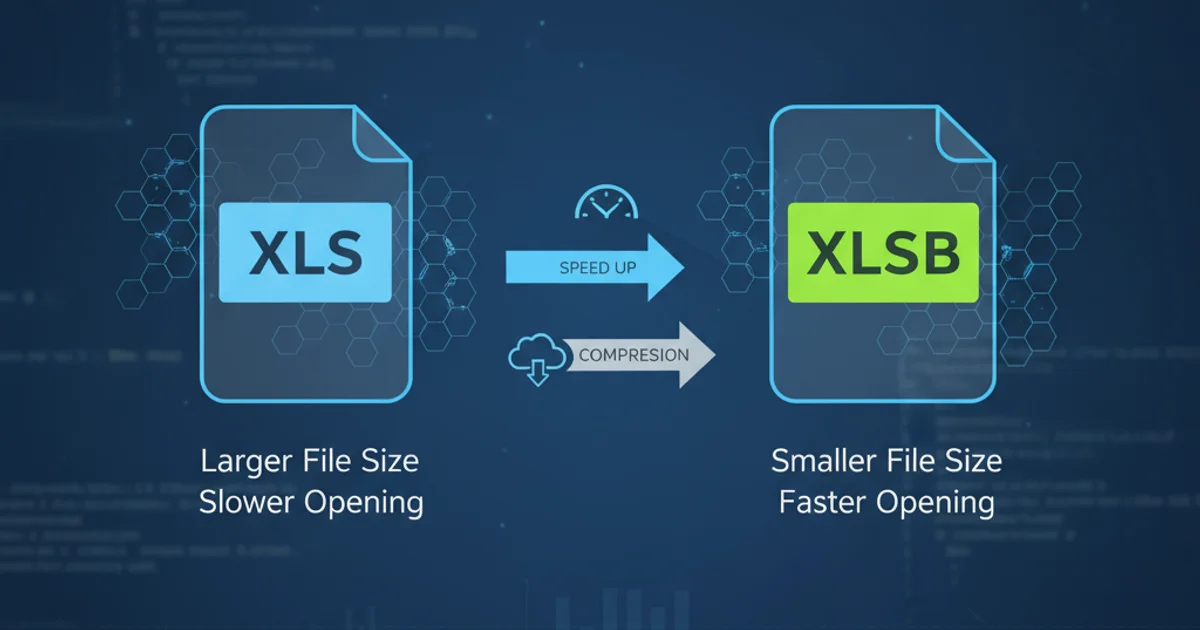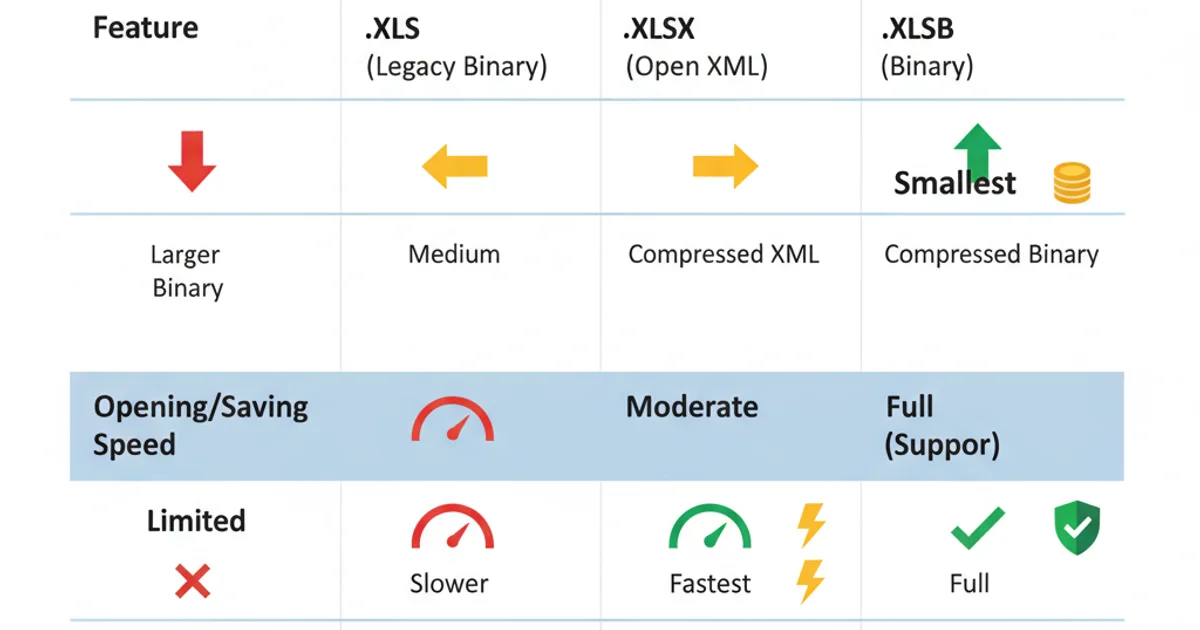End user difference between .xls and .xlsb?
Categories:
Excel's Binary Advantage: Understanding .xls vs. .xlsb for End Users

Explore the key differences between Excel's traditional .xls format and the binary .xlsb format, focusing on performance, file size, and compatibility for end users.
When working with Microsoft Excel, you often encounter various file formats. Two of the most common, especially for older or larger workbooks, are .xls and .xlsb. While both serve to store Excel data, their underlying structures and performance characteristics differ significantly. This article aims to clarify these differences from an end-user perspective, helping you choose the most appropriate format for your needs.
The Legacy: .xls (Excel 97-2003 Workbook)
The .xls format is the traditional Excel file type, primarily associated with Excel versions 97 through 2003. It uses a proprietary binary format known as the Binary Interchange File Format (BIFF). While widely compatible with older software, it has several limitations in modern Excel environments.
Key characteristics of .xls:
- Row and Column Limit: Limited to 65,536 rows and 256 columns.
- File Size: Generally larger than
.xlsxfor the same data, and often larger than.xlsbfor complex workbooks. - Performance: Can be slower to open, save, and process, especially with large datasets or complex calculations.
- Features: Does not support many of the newer Excel features introduced in Excel 2007 and later, such as a significantly larger grid, new functions, and improved charting.
- Compatibility: Excellent for backward compatibility with very old Excel versions.
The Modern Standard: .xlsx (Excel Workbook)
Before diving into .xlsb, it's crucial to understand .xlsx, which became the default format starting with Excel 2007. The .xlsx format is an XML-based, zipped file format (Open XML). It's designed for modern Excel features and improved interoperability.
Key characteristics of .xlsx:
- Row and Column Limit: Supports over 1 million rows and 16,000 columns.
- File Size: Typically smaller than
.xlsdue to XML compression. - Performance: Generally good, but can become slow with extremely large or complex workbooks.
- Features: Supports all modern Excel features.
- Compatibility: Widely compatible with Excel 2007 and newer, and many other spreadsheet applications.
The Binary Workhorse: .xlsb (Excel Binary Workbook)
The .xlsb format, introduced with Excel 2007, is a lesser-known but powerful alternative. Unlike .xlsx which uses XML, .xlsb stores data in a proprietary binary format, similar in concept to .xls but updated for modern Excel capabilities. It's essentially a binary version of the Open XML format, optimized for performance and file size.
Key characteristics of .xlsb:
- Row and Column Limit: Supports over 1 million rows and 16,000 columns, just like
.xlsx. - File Size: Often significantly smaller than both
.xlsand.xlsx, especially for workbooks with many worksheets, complex formulas, or extensive formatting. This is its primary advantage. - Performance: Generally the fastest format for opening, saving, and performing calculations on large and complex workbooks.
- Features: Supports all modern Excel features.
- Compatibility: Compatible with Excel 2007 and newer. Older versions of Excel cannot open
.xlsbfiles. - Interoperability: Less interoperable with non-Microsoft applications or tools that rely on the Open XML structure (like some data analysis tools or programming libraries that parse XML).
flowchart TD
A[User Needs] --> B{Large Data / Complex Formulas?}
B -->|Yes| C{Performance Critical?}
C -->|Yes| D[Choose .xlsb]
C -->|No| E[Choose .xlsx]
B -->|No| F{Backward Compatibility (Excel < 2007)?}
F -->|Yes| G[Choose .xls]
F -->|No| E
E --> H[Standard Use Case]Decision Flow for Choosing Excel File Format
.xlsb can often yield noticeable improvements in opening, saving, and calculation times. Always test with a copy of your file first!When to Use Which Format
Understanding the nuances helps in making an informed decision:
Use
.xlswhen:- You absolutely need to share the file with users who only have Excel 97-2003.
- You are working with extremely old systems that only support this format.
- Note: This use case is increasingly rare and generally discouraged due to limitations.
Use
.xlsxwhen:- It's your default choice for most modern Excel work.
- You need broad compatibility with Excel 2007+ and other spreadsheet software.
- Interoperability with other applications (e.g., those parsing XML) is important.
- File size and performance are not critical bottlenecks for your typical workbook.
Use
.xlsbwhen:- You are dealing with very large datasets or highly complex workbooks where
.xlsxbecomes slow. - File size reduction is a priority (e.g., for faster network transfers or storage).
- Performance (opening, saving, calculating) is paramount.
- All users of the file have Excel 2007 or newer.
- Interoperability with non-Excel applications is not a primary concern.
- You are dealing with very large datasets or highly complex workbooks where

Comparative Overview of Excel File Formats
.xlsb offers performance benefits, its proprietary binary nature means that some third-party tools or programming libraries (especially those designed to parse the Open XML structure of .xlsx) might not be able to read or write .xlsb files directly. Always consider your ecosystem before committing to .xlsb for shared or automated processes.In summary, for most users, .xlsx remains the standard and recommended format. However, for those pushing the limits of Excel with massive datasets or intricate calculations, .xlsb provides a powerful, performance-oriented alternative that can significantly improve the user experience by reducing file size and speeding up operations.